Hesperian Health Guides
How Can We Help?
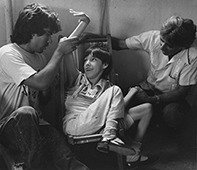 |
| A village worker and father examine a child with severe cerebral palsy. |
First, with the help of parents and family we observe the child carefully to see:
- what the child can do.
- what he looks like when he moves and when he is in different positions.
- what he cannot do, and what prevents him from doing it.
Contents
WHAT THE CHILD CAN DO
Can the child:
- lift her head? hold it up? sit? roll over?
- pull herself along the floor in any way possible? crawl? walk?
How does the child use her hands?
- Can she grasp things and hold on; let go; use both hands together (or only one at a time)?
- Can she use her fingers to pick up small stones or pieces of food?
How much can the child do for herself?
- Can she feed herself; wash herself; dress herself? Is she ‘toilet trained’?
What can the child do in the home or in the fields to help the family?
After observing and discussing what the child can do, we must expect him to do these things. If the parents are used to doing almost everything for the child, at first this may be difficult (for both parents and child). But soon it will help the child have more confidence. The parents, also, will be encouraged by seeing what he can do for himself, and they will think less about what he cannot do. Here a grandmother helps her grandchild became more self-reliant:
 Granny, I'm thirsty.
There's water in the jug. Help yourself.
I put the jug close to the ground so you can try!
I can't. Please Granny! | ||||
 Look, Granny! I did it!
I'm proud of you Pepe!
Now please bring me some firewood. |
It was difficult for the grandmother not to bring her grandson a cup of water— especially when he begged her. But she understood that in the long run it would do him more good to manage for himself. For more ideas about how a family can help a child with cerebral palsy, read the story of Maricela and the story of Enrique.
Helping the Child Achieve Better Positions
Due to abnormal pull of muscles, children with cerebral palsy often spend a lot of time in positions that can cause further disability. For example:


Whenever possible the child should be in positions that prevent rather than increase disability. Whatever the child is doing (lying, sitting, crawling, standing) try to encourage positions so that:
|
 sitting
crawling
lying
standing |
| Encourage positions that the child can manage at her stage of development. Play with her, talk with her, give her interesting things to do in these positions. |
 sandbag to help keep arm straight and quiet
pad to keep head from tilting
padded block between knees
and between feet to hold them apart
board to hold pad
padded blocks carefully placed to keep body from bending sideways
footrest to prevent tiptoeing |
| Not all children will be able to stay in these positions without some kind of support. Special chairs, tables, wedges, pads, or bags of clean sand may be needed to keep a good position. | |
| For example, the child above might need a chair like this: |
WARNING!
Do not leave a child in any one position for many hours as his body may gradually stiffen into that position. Change his position often. Or better, encourage him to change it. If he can change his own position effectively, then chairs, seats, and other aids must not prevent him from moving.
AIDS SHOULD RESTRICT A CHILD’S MOVEMENT AS LITTLE AS POSSIBLE.
When the child with cerebral palsy moves she may do so in an unusual way. To some extent this should be allowed, as long as the child is able to do things as best she can. But also show the child other ways to move in order to correct some of the positions that she repeats again and again. For example:
| If her arm repeatedly bends up. | encourage her to reach out and hold objects. | Or she may need a post to hold on to. |
 | ||
| If she bends backward a lot, | she needs actions that bend her head, body, and shoulders forward, like these. | |
 | ||
Corrective actions and positions can be found while working in the fields, in the home, or while playing with younger family members. Here are some more suggestions for corrective positions (from physical therapists Nancy Finnic and Sophie Levitt).
Lying and sleeping
| Try to find ways for the child to be in positions that correct or are opposite to his unhealthy ones. |  |
For example, if the baby’s knees usually press together or his legs cross like scissors, |
 |
The baby’s legs can be held apart by using many thicknesses of diapers (nappies) like this, |  |
| or by pinning her legs like this (when sleeping). |
| If the child’s body often arches backward, | try positioning him to lie and play on his side. |
 |
 |
| Look for ways to work against the spasticity by bending him forward, | or over a barrel (or beach ball or big rock, etc.), | or in a car tire swing. |
 |
 |
 |
| If the child does not have enough control to reach out in this position, | help position him so he can lift his head using his arms. | hole in the ground to prevent tiptoeing |
 |
 |
 |
| If the child’s head always turns to the same side, | do not have him lie so that he turns his head to that side to see. | Instead, have him lie so that he has to turn his head to the other side to see the action. |
 |
 |
 |
For more suggestions on head control, see "Activities to Help the Child Lift and Control Her Head".
Rolling and twisting
A child with cerebral palsy is often very stiff when it comes to twisting or rotating the main part of her body. However, such twisting is necessary for learning to walk. Rolling also helps develop body twisting.
| If the child is very stiff, first help him “loosen up” by swinging his legs back and forth. | Then help him learn to twist her body and roll. | Figure out games so that the child wants to twist, and does it without help. | |
 Reach for the toy. Good boy! | |||
For more ideas to develop twisting and rolling, see "Activities to Encourage Rolling and Twisting".
Sitting
The way that you help position a child for sitting also depends on the type of unhealthy body positions he has. For example:
| If his legs push together and turn in, and if his shoulders press down and his arms turn in, | sit him with his legs apart and turned outward. Also lift his shoulders up and turn his arms out. | Look for simple ways to help him stay and play in the improved position without your help. | Sitting with the legs in a ring helps turn hips outward. |
 |
 |
 |
 |
| For the child with spasticity who has trouble sitting, you can control his legs like this. This leaves your hands free to help him control and use his arms and hands. Help the child feel and grasp parts of his face. | Sit the child on your belly with his legs spread and feet flat. Give support with your knees as needed. As he begins to reach for his face, help his shoulders, arms, and hands take more natural positions. Make a game out of touching or holding parts of his face. MAKE IT FUN! | ||
 |

Now touch your nose.
Good boy! | ||
| As the child develops, encourage her to put her arms and body in more healthy positions through play and imitation. | Children who have trouble with balance (from cerebral palsy, polio, or other disability) often sit with their legs in a ‘W’ in order not to fall over |
 |
 |
| Sitting in a “W” should usually be discouraged because it can increase contractures and loosen or damage hips and knees. However, if it is the only way a child can sit and use her hands, it should be allowed. |
| Look for ways for the child to sit with legs spread forward. Here are 2 examples: | ||
 |
The pot or log keeps the knees apart. The holes for heels help too. |  |
| If the child’s legs stay apart, his butt sticks out, and his shoulders are pulled back, | first sit him with his body bent forward and his legs together. Then bend his shoulders forward and turn them in. | ||
 |
 | ||
| A sack of grain provides a roll to hold this child’s legs apart. Her father pushes down on her knees. This helps her to hold her feet flat and sit up straighter. (PROJIMO) | Look for ways that the child will sit and play in the improved position without help. | ||
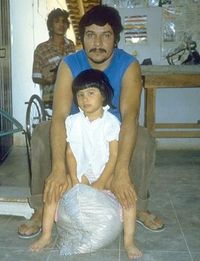 |
 | ||
| Play with her at a table. Sit across from her to have her reach forward for toys with both hands. | Be sure her feet are on a flat surface. | ||
For ideas on special seats and sitting positions to prevent "knock-knee" contractures, see below. Other ideas on special seats for children with cerebral palsy:
- "Activities for Standing, Walking, and Balance"
- "Sitting Aids"
- "Adaptations for Wheelchairs and Other Sitting Aids" to "Carefully Evaluate What Kinds of Support Each Child Needs"
- "Plywood Frame Wheel Chair"
- "Details of How to Make Wheel Chair Parts".
Moving about
Because children with cerebral palsy are usually delayed in walking, they need other ways to get from place to place. The methods used will depend on both the needs and abilities of the child—also the resources, skills, and imagination of family, friends, and local crafts persons.
Aids for ways to get from place to place should provide corrective positions
The following examples are all designed to help prevent “knock-knee” contractures. They also provide other types of corrective positioning.
 |
 half of an old bucket or drum
“lights” (jar tops)
padding
casters (wheels that turn sideways) |
 bell ring
strap (if needed) |
| Wheelboards | Adapting wheel boards for travel on rough surfaces. | Some children will need wheelchairs. |
 |
 padding |
 |
| Pad or put a pillow over this support. (Some children will not need this support.) | By placing large wheels near the middle, if the smaller front caster gets stuck, the child can lift with his arms and go on. Or if a fixed front wheel is used, he can lift it off the ground to make turns. For dirt or bamboo floors, larger wheels will be needed. | For wheelchair designs, see Chapters 64, 65 and 66. See examples of special cushions, to help hold a child’s hips back and her knees apart. |
For other wheelboard designs, see "Wheelchair with Lying Board".
Standing
Many children with cerebral palsy stand and walk in strange positions. A child’s unsure balance often increases the uncontrolled tightening of certain muscles and makes balance even more difficult.
| As a result the child stands in an awkward position that can lead to deformities and contractures. | When you help the child keep her balance, she is less tense and can stand straighter. |

swayback
bending leading to contractures
tiptoeing |
 |
| Look for ways to provide similar assistance during play and other activities. Here a cart provides easier balance and keeps the arms straight. |
 |
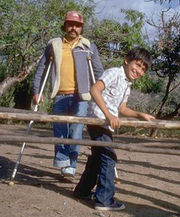 |
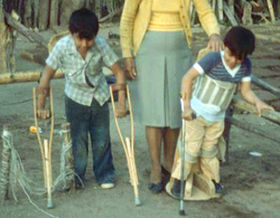 |
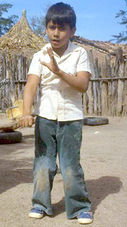 |
| Miguelito began to walk at age 8 — first on parallel bars. | Soon he learned to use crutches. Here he races another child who is learning to walk. | And now he can walk alone. |
 |
Two sticks can help the child once she develops some standing balance. At first you can hold the tops of the sticks. But let go as soon as possible. |
|
CAUTION! Be sure sticks are taller than child so that she will not injure herself if she falls. |
The child who cannot yet stand alone can be placed in a standing frame for an hour or 2 each day.
 |
board or plywood leaned against the table strap (if needed) wedge made from cardboard, foam, or other material | |
 |
||
Even for the child who may never stand alone or walk, standing in a frame helps prevent deformities. It also helps the leg bones grow and stay strong. Start at about the age most children begin to stand—around one year old.
For ideas on standing frames see "Standing Aids".
Hand use
Try to find ways that the child can play or do things using her hands while she is in the corrective positions of sitting, standing or lying.
Encourage her to touch, feel, and handle as many different shapes and surfaces as possible: things that are big, small, hot, cold, sticky, smooth, prickly, hard, soft, thin, and thick.
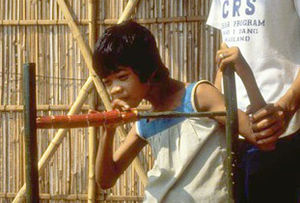 |
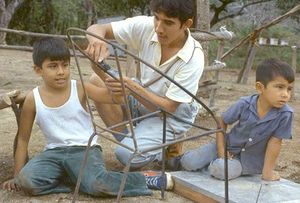 |
| This girl in the rehabilitation center of the Khao-i-dang refugee camp in Thailand develops hand control by sliding colored rings on a pole. | A boy with cerebral palsy at the PROJIMO rehabilitation center helps paint a chair frame. |
For more ideas of developing use of the hands, see "Activities to Help Develop Gripping, Reaching, and Hand‑Eye Coordination".
CORRECTIVE CARRYING POSITIONS
As in other activities, try to carry a child in positions that work to correct unhealthypositions.
 |
 |
do not carry him like this |  |
Carry him in ways that straighten his arms and bend his knees and hips. |
| If the child usually lies with arms bent and legs straight, |
| As the child gains more control, you can carry him with less support. | The child with spasticity who is usually curled up, can be carried like this. | |
 |
 |
 |
| The child with severe spasticity who tends to straighten and arch backward can be carried like this. |  |
|||
| Pushing shoulders up helps relax tight spasms of the legs. | 
| Holding the child by his inner thighs helps turn legs out as they separate. |  |
While working, you can carry the baby with legs spread across your hips or back, as is the custom in many places. |
See "Good Carrying Positions".


